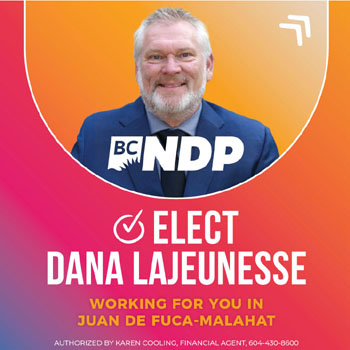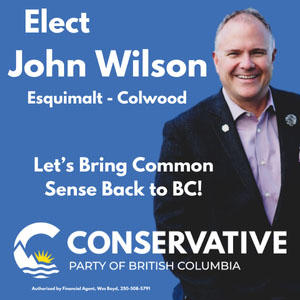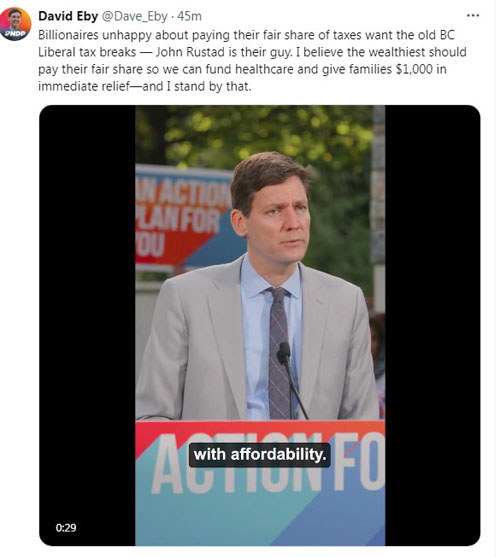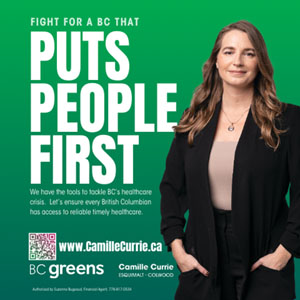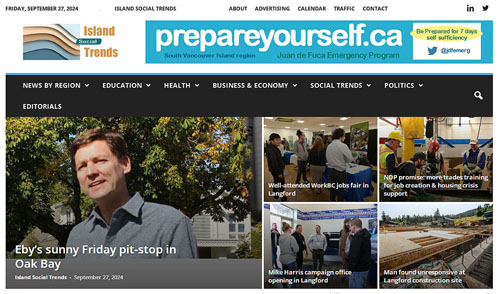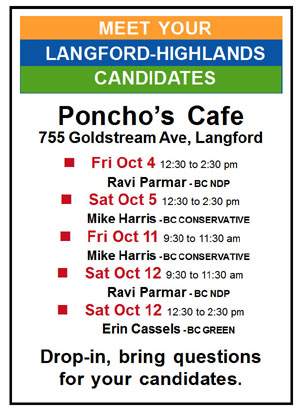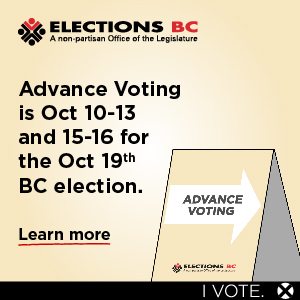
Sunday October 6, 2024 | VICTORIA, BC
BC ELECTION CAMPAIGN DAY 16 of 28
Political campaign news analysis by Mary P Brooke | Island Social Trends
Your 28-day voter’s guide for BC Election 2024
While it is quite apparent that either the BC NDP or BC Conservatives will form government after the October 19 provincial election, a clear winner is not yet evident.
For the last seven years in BC there has effectively been a majority BC NDP government. That was constructed as a progressive coalition of the NDP and Greens from 2017 to 2020 followed by a full-on BC NDP majority from 2020 until the writ dropped on September 21, 2024 to launch the 43rd BC general election.
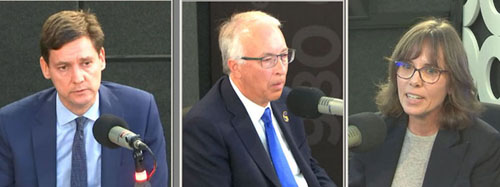
The role of the BC Green Party has been understated in all this. Without the Greens the NDP would not have been able to steal away the 2017 election (using the Supply and Confidence Agreement mechanism) from the BC Liberals who had held power for 16 years (2001-2017). Then Premier John Horgan later managed to turf his reliance on BC Greens by calling a snap election in the fall of 2020 during the pandemic, charging ahead with NDP on its own with a strong majority (allowing for more sweeping and faster reform in areas of social programs, clean energy, and housing).
Now in the 2024 election the BC Greens are playing a ‘small but mighty’ role in the campaign dynamic, and hoping to continue that placement after the October 19 election with a small but impactful team of MLAs in the 43rd BC Legislative Assembly.
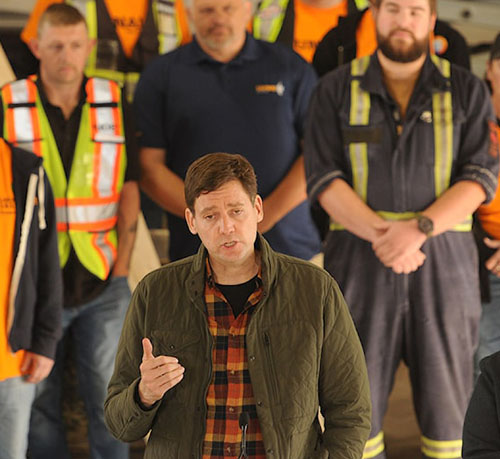
During 2020-2024 with only two MLAs (party leader Sonia Furstenau and third-party house leader Adam Olsen) the BC Greens brought forth debate and contributions to legislation which often served to keep the surge-ahead NDP side of the house on its toes.
Continuing on as BC Green Party leader for the next legislative round, Furstenau has repeatedly pitched a hope for about five to seven BC Greens to end up as MLAs in the legislature after October 19.

All three party leaders have been participating in public debates in this election: Premier David Eby (BC NDP), John Rustad (BC Conservatives), and Sonia Furstenau (BC Green). The first province-wide debate on CKNW radio on October 2 was widely listened to (and viewed online). The next full-on leaders debate is coming up on Tuesday October 8 at 6:30 pm on Global TV [Visit the BC Election 2024 News Section for analysis.]
Two-party standard benefits by third party presence:
If we look to south of the Canadian border there is a stark example of polarized politics between two major parties (Republican and Democrat).
Here in Canada we enjoy the benefits to democracy of having a third party to keep political discourse moving beyond the old British parliamentary style of power concentrated at the top that flips back and forth over the years from what is generally seen as center-right (Conservative) to center-left (Liberal).
The NDP federally presents itself as the ‘voice’ or ‘conscience’ of the people, and takes that tack provincially as well in BC (also currently in Manitoba and previously in Alberta for a few years).
The old two-party back-and-forth is playing out in spades in the BC general election this month. With 93 candidates each (one in each electoral area), either one of the BC NDP or BC Conservatives will form government. But what could be seen as a healthy mix of voter preference will be seen in several ridings where the BC Greens will claim votes, or perhaps even some candidates who are running as independents.
BC NDP Leader Eby almost never mentions the Greens. That’s probably the right thing to do. His campaign attacks these past two weeks have been repeatedly against John Rustad (without much mention of the BC Conservative affiliation). That’s understandable. The province has made considerable progress for a wider range of people under the BC NDP since 2017; it would be a shame to lose that momentum because of the upstart political direction set by one former BC Liberal cabinet minister whom Eby colours as out of touch and without a strong policy framework.
Two-party pendulum:
If we hope that our system of governance reflects how our society functions then it’s charming at best to think that a two-party pendulum swing from right to left is the best way to go.
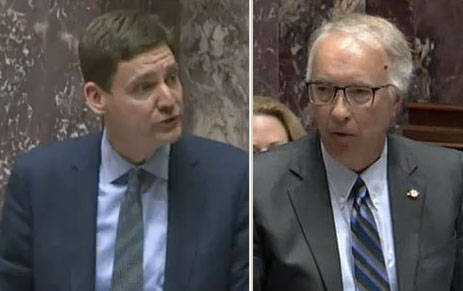
Life and democracy are messy, with plenty of range between black and white absolutes. Recognizing the need to have continual injection of fresh ideas and to facilitate adoption of those ideas into the mechanics of government and society is probably helpful, if not now necessary. Achieving some some economic vibrancy and effective social ecology will happen by way of collaboration among many well-intentioned leaders.
Where will Greens succeed?
Where will Green votes come from? Not from people who are die-hard loyal to either NDP/left or Conservative/right.
There are devoted Green voters already in BC after their now 40+ years as a party on the provincial landscape. But in every election there are so-called independent voters — folks who review and assess the issues and make a choice for the moment of this election in this current set of socioeconomic and political circumstances.
Those are the voters that the Greens want to capture in this election in order to boost their MLA count above two for the 2024-2028 phase of BC politics.
Breaking the mold:
What’s interesting is that the Green presence still hasn’t hit the radar for some sectors. For example, recently the BC Teachers Federation posted a comparison of vote preference (by issue or concern) with a chart including only BC NDP and BC Conservatives.
Until last year, the BC Conservatives were hardly a known political force at all (they ate the BC United Party’s lunch this year, causing the complete demise of the BC United formerly BC Liberal party in the 2024 political landscape).
It sounds like Rustad was getting a lot of support from would-be candidates (including John Wilson now running for the BC Conservatives in Esquimalt-Colwood and Mike Harris running in Langford-Highalnds who joined the party to help out and became a candidate) to consolidate the right-hand spectrum in order to give new candidates a fighting chance against the BC NDP.
Despite the robust control of the corporate two-party style of government in Canada and most provinces, it’s a bright light in Canadian politics that we invite and sustain a third-party choice (federally that’s the NDP, provincially in BC that’s the Greens). Ironically, in not expecting to form government (either as a majority or minority), in BC that leaves the Greens with a greater sense of freedom to propose new ideas; electorally speaking that picks up single-issue voters who might otherwise just vote for the status quo.
Treading into status quo territory:
With further irony, the BC Greens are becoming part of the status quo by being the ‘unique’ or ‘lone’ voice on certain issues. The Green roots are based in protection of the environment, but that emphasis — while still prominent even in their party name — has become part of a suite of policy directions that see society and the economy more holistically, calling it a well-being framework in their October 1 platform announcement.
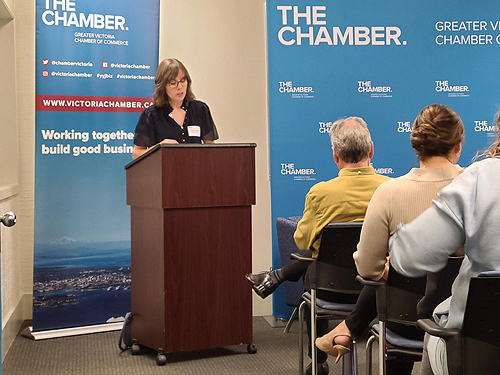
Forming government is about having the power to rule. As a majority government the ruling component is clear. As a minority government there is still force of running government with the requirement of more debate and collaboration with the Official Opposition and (in BC particularly) the official third party. Being the voice or conscience of the political landscape is a freeing experience for the third party — they can pitch ideas without necessarily having to bear the burden of implementing them.
Possibly one of the reasons Premier Eby rarely mentions the Greens is becausing if he returns with a BC NDP minority government he knows he will probably be able to glean some progressive ideas from the BC Greens as the official third party in the legislative assembly.
Half-way point:
The 28-day BC Election campaign is now just past the half-way mark. The writ dropped on September 21 and the election is coming up fast on October 19.
The two larger parties have been busting out missives against the other through the first two weeks of the election campaign. As the newcomer force it seems natural that the BC Conservatives would hurl criticisms toward the BC NDP, while the BC NDP approach seems to be a heavy focus on the BC Conservative leader by name: “Who is John Rustad?”.
Oops, helping the opponent:
There couldn’t be a better public relations effort to help Rustad and the BC Conservatives than when the BC NDP mention their opponent’s name front and center, repeatedly.
While criticizing the BC Conservatives as their main opponent, the BC NDP has gone straight for the jugular on the opposing party’s leader. Apparently that strategy was produced out of input from focus groups but seems to have become misshapen or too heavily depended-upon during processing into a centralized NDP campaign.
“The BC NDP, like most political parties, uses a variety of research methods like focus groups to hear from British Columbians about the issues that matter most to them,” says BC NDP Provincial Director Heather Stoutenburg.
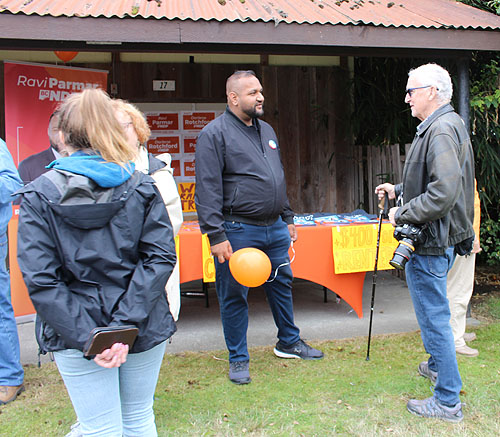
“We will continue to use the tools at our disposal to make sure we are connecting with people about how we can meet their needs,” she said in a statement to Island Social Trends this past week.
BC NDP candidates across the province have obviously been grilled about verbalizing the anti-Rustad approach. Clearly the BC Liberals left many British Columbians in the dust during 2001-2017 and the BC NDP surged into power in 2017 based on wanting to fix all that (in education, health-care and infrastructure).

But on the ground in community the continual grinding away at the BC Conservatives is often rubbing attentive voters the wrong way. There is a visceral response at attacking rather than leading with informative reasons as to why the BC should be re-elected. That’s not to be naive about how campaigns work. It’s an observation at debates and meet-and-greets. This didn’t seem to happen before in election phases; the electorate seems to be exhibiting a changing expectation of decorum and approach of their candidates.
Calling out questionable candidates:
That expectation of decorum and professionalism also applies to BC Conservative candidates who, for example, make claims about vaccines that are without scientific basis and therefore misleading or even dangerous.
Eby is right to point out that Rustad has proliferated his campaign slate with candidates who have not become refined politicians or at the very least properly informed.
When Rustad turns a blind eye to that and allows such candidates to stay in the race, it either reaffirms a goal to ‘win a majority at any cost’ or that he agrees with the viewpoint of said candidates (or thinks it not important enough to change course now).
Progress by BC NDP over 7 years:
But the BC NDP could be overdue for having slipped into the shoes of ‘successful savior.’ They are now the adults in the room, and with a kinder socioeconomic edge than the BC Liberals before them.
They are getting pretty good at precise-target financial benefits for individuals, families and households, delivered through tax credits and rebates.
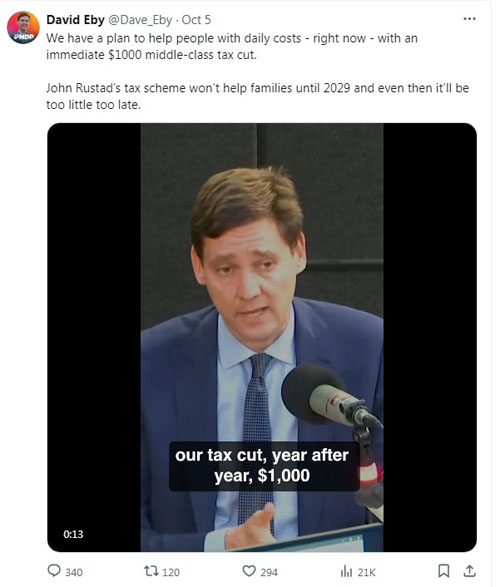
The BC NDP has made significant progress with building more schools and hospitals, eliminating MSP premiums,and controlling fares on BC Ferries routes. They removed tolls from bridges in the BC lower mainland, improved highways in more remote areas and on Vancouver Island, lowered auto insurance rates and providied affordability rebates. In the bigger picture it was the NDP who cleaned up money-laundering in BC casinos and restored the financial health of ICBC. These are powerful stories that have mostly been left to the wayside in Election 2024.
Voters in these last days of the election campaign are still needing to hear an encapsulation of that success rather than how awful the competition would or might be if they won. Why even give them room to win (in the voter’s mind) if you’re hoping for your own team to win. This smacks of political centralization and losing touch with voters in the community.
Keeping government on its toes:
As with all things in life ‘be careful what you wish for, you might just get it’. If the Greens substantially increase their seat count coming out of the October 19 election, they will of course need to think more strategically about the dynamics of votes in the legislative assembly. They will lose some of their ingenue charm but gain the power they seek to make real change in some new and fresh directions.
All of this might possibly keep the current leading government NDP on its toes. The BC Conservatives — sweeping out of nearly nowhere to landing on a large platform on the provincial stage this year — is less likely to be paying attention to anything other than toppling the Eby-led NDP government.
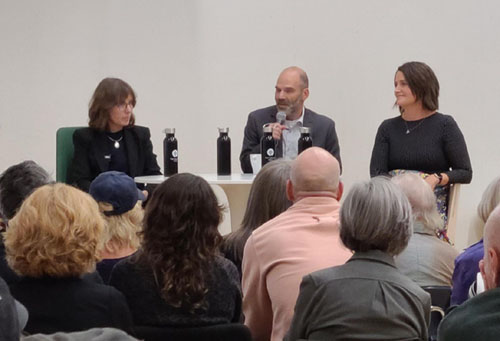
As BC Green party leader Furstenau obviously has this ground-breaking achievement (more MLAs after October 19) forefront on her mind. That’s on top of the dramatic shift in her own campaign territory from rural Cowichan Valley (where she won in 2017 and 2020) to urban turf in Victoria-Beacon Hill where she’s battling out the MLA race against high-profile BC NDP cabinet minister Grace Lore (who has the legacy of carrying support from the former Deputy Premier Carole James voter base).
Unique and significant change:
Three parties, and now only 13 days to go. The October 19 election seems to have surfaced the possibility of unique and significant change to the BC political landscape rather than BC NDP ‘more of the same’ that might have been expected only six months ago.
Back in February the BC NDP announced the appointment of a campaign manager who was a key advisor on the 2017 and 2020 BC NDP campaigns and has apparently helped elect seven Premiers across Canada. She seems to have led a strategy that focuses on ‘who is John Rustad’ which might be now backfiring.
As pushback, the BC Conservatives could pull off a win that places them as a minority or even majority government with the help of a BC NDP campaign that mentions Rustad as much as it does the details of the BC NDP platform.
This is a problem with corporate-style politics relying on polls and focus groups that are provided by businesses as a corporate service. The BC NDP has fallen into that trap of shifting to a more corporate style in its management style (starting under former Premier John Horgan) and while trimmed a bit under Eby has maintained a ‘we’ve got this right’ mentality. They might be right on many issues, but over time they’ve left less and less room for discussion and debate. The sense of urgency is understandable.
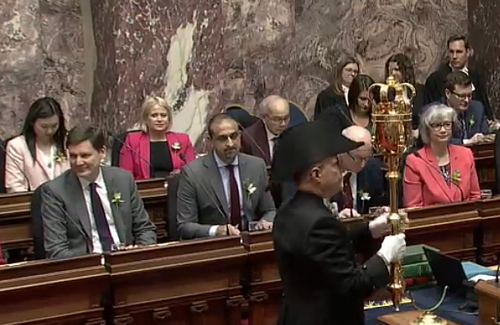
Every day as if it’s your last:
Horgan was heard many times saying to his MLAs to ‘work every day as if it’s your last’. That was not overly dramatic, given the many shortfalls they needed to make up for after how the BC Liberals had previously managed the government and led the province (leaving many people behind).
But the BC NDP could have taken their foot off the gas pedal just a bit by way of accepting new ideas and more debate; that would keep them in power longer more so than using their majority government with a heavy-hand. They might be having less of a fight right now if they’d not been quite so relentless for so long. Easy to say. If any of us had been sitting in the BC NDP shoes during the ongoing affordability challenge and housing crisis of 2020 to 2024 we might have used power in the same way. Dramatically.
Power with the voters:
As with every election — though we tend to sometimes forget — the power is with the voters. In 2024 there is an undercurrent of ‘enough is enough’. Not about the BC NDP necessarily but about the stale stodgy corporate way that large political parties choose to function. The BC Conservatives are paving over some significant ground in this election by capitalizing on the electorate’s mood for change (which is normal after any government has been in power for a while) including capitalizing on the federal Conservative party momentum under Pierre Poilievre.
But the BC Conservatives may be surprised at how trying to be mainstream could backfire. If voters have enough time in their busy lives to really think about how they want the province to move forward: in new ways, not old ways.
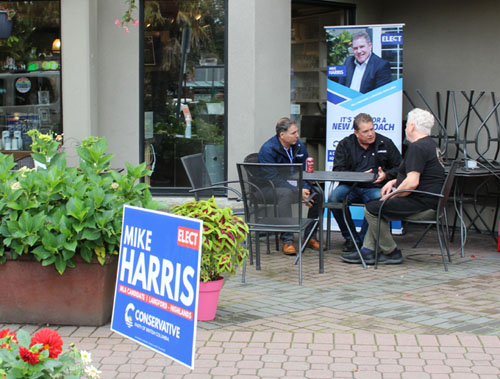
Premier Eby seems a bit stuck in the positive power of announcing good things for people. That works well during times of governance. But that approach needs amplification with election-style fervor if the BC NDP messaging is going to resonate above the fray of this-and-that about their competition, and translate into additional votes from independent or undecided voters.
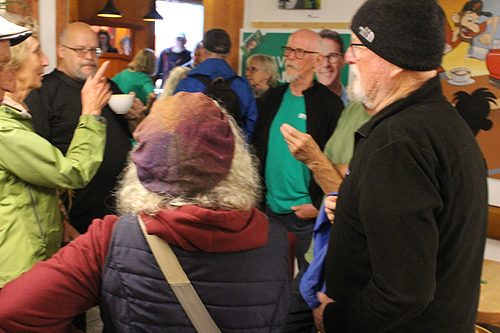
Almost all of the BC Conservative candidates are thirsting for power (through becoming an MLA) over and above having developed any deep political philosophy over the years. Many of them have never been in politics before. Jumping suddenly into a position of power is an intoxicating force.
The BC NDP seems to fully believe in the benefits they have brought to BC since 2017 and may not yet realize how all that progress could be steam-rolled over by the simple gut-level desire of BC Conservatives to win in most of the ballot boxes across 93 ridings on October 19.
Advance voting starts this week:
Advance voting as organized by Elections BC starts this coming week, available on Thursday October 10 and Friday October 11, and through the Thanksgiving weekend on Saturday October 12 and Sunday October 13.
After a day off on Thanksgiving Monday, there will be more advance voting on Tuesday October 15 and Wednesday October 16.
Each of the three main parties is counting on their loyal base to get out and vote. Perhaps many already have (at District Electoral offices, or by mail).
If the campaign rhetoric and promises don’t deliver new enthusiasm to grab the interest of independent-thinking voters over the next 13 days, the final result on October 19 could be a dramatic surprise across the province.
Some possible upsets to watch for locally:
- BC Green Leader Sonia Furstenau could lose to the BC NDP’s Grace Lore in Victoria-Beacon Hill. If that happens she would probably remain as party leader at least for a while but would be out of the legislature. The BC Conservatives are presenting Timothy Thielmann as their candidate.
- BC NDP incumbent Ravi Parmar running in the newly-boundaried Langford-Highlands could be pushed off the seat by BC Conservative candidate Mike Harris if enough business-first voters come out to vote on October 19. The BC Green momentum is also strong in that riding and could siphon away BC NDP votes.
- Esquimalt-Colwood (which includes View Royal and VicWest) is up for a dramatic ride in this election. Upon losing Mitzi Dean as their expected stalwart candidate, the BC NDP has brought in a new last-minute candidate in Darlene Rotchford, after which the BC Conservatives landed with a slam in announcing long-time businessman and Chamber of Commerce leader John Wilson as their candidate. Well-recognized health-advocate Camille Currie as the BC Green candidate has a right on her hands as the two main parties battle it out here.
- The Juan de Fuca-Malahat race is a three-way heat between two well-known Sooke locals (Dana Lajeunesse for the BC NDP and David Evans for the BC Greens) and a thoughtful medical doctor (Marina Sapozhnikov) who is leading the way for the hungering conservative/right-leaning vote in that area.
- In Victoria-Swan Lake the BC NDP used to rely on Rob Fleming to bring it home. Now it’s an open race between Christina Winter for the BC Greens, Nina Krieger for the BC NDP, and Tim Taylor for the BC Conservatives.
- The Saanich South riding may very well re-elect BC NDP cabinet minister Lana Popham. She is a local regional force and already has a province-wide profile after handling both the agriculture ministry under former premier Horgan and over the past two years the tourism, sport and arts file under David Eby. BC Green candidate Ned Taylor (while well known as a former Saanich municipal councillor) may not stand a chance against the Popham political machine. The BC Conservative candidate is Adam Kubel.
Follow IslandSocialTrends.ca for election campaign cover, and results on election night. To get direct emails about BC Politics during the campaign, becoming a Premium Digital Subscriber.
===== RELATED:
- BC Leaders debate on October 8 on Global TV (October 8, 2024 – link to come)
- BC party leaders clash in radio debate Oct 2 (October 2, 2024)
- BC Greens push for well-being framework in Election 2024 (October 1, 2024)
- BC Greens pitch smart economy & robust safety net (September 10, 2024)
- NEWS SECTIONS: BC ELECTION 2024 NEWS | POLITICS | HEALTH CARE
- BC ELECTION CALENDAR: 28-DAY ITINERARY & CALENDAR



